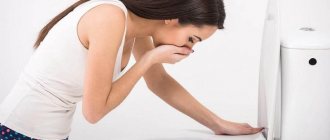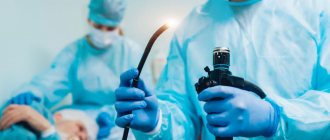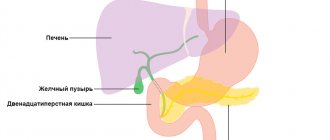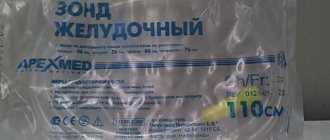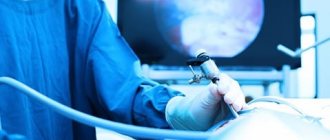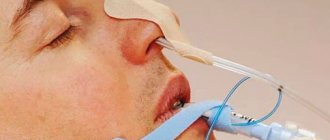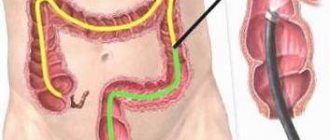Gastroscopy is a diagnostic procedure that helps evaluate various symptoms, including persistent epigastric pain, nausea, vomiting, or problems swallowing, and also search for and treat the cause of upper gastrointestinal bleeding. Gastroscopy is also a more accurate study than fluoroscopic methods for detecting changes in the mucous membrane of the esophagus, stomach and duodenum, characteristic of inflammation, erosions, ulcers, cancer or other processes. A specialist may perform an upper endoscopy to perform a biopsy (obtaining soft tissue samples) to differentiate between benign and malignant tumors, as well as to diagnose celiac disease or test for Helicobacter pylori, a bacterium that causes recurrent gastroduodenitis, gastric or duodenal ulcers. Gastroscopy is also used for therapeutic purposes, to stop bleeding, remove polyps or apply topical medications.
What it is?
Transnasal gastroscopy is an FGDS method in which an endoscope is inserted through the nasal passage instead of the oral cavity . The probe then passes through the back wall of the nasopharynx and oropharynx, the larynx and enters the esophagus. At its end there is a small video camera with lighting, the image from which is shown on the screen. This allows the doctor to control the progress of the device, as well as examine the mucous membrane and contents of the upper part of the digestive tract. The endoscope also necessarily has a sensor that measures the acidity of the environment.
If necessary, with transnasal gastroscopy, as with conventional FGDS, of the altered area of the mucous membrane can be performed This sample is then sent to the laboratory for cytological examination.
Help The diameter of the endoscope, which is used for transnasal insertion,
is 7-7.5 mm , which is significantly smaller than that of a conventional probe (9-10.5 mm). That is why the procedure is much easier to tolerate.
Sedation and anesthesia
Before the gastroscopy procedure, the patient's pharynx is treated with lidocaine in order to reduce pain and other negative effects that occur when the endoscope is inserted. If the client needs, gastroduodenoscopy of the stomach is performed under anesthesia. In this case, intravenous anesthesia is performed, which causes relaxation and light sleep. Patients wake up within an hour, but the effects of the drugs are longer lasting, making it unsafe to drive until the next day. General anesthesia for medical reasons is provided only in special cases (in young children and when planning very complex procedures).
Indications for transnasal EGD
FGDS is one of the most commonly used diagnostic techniques in gastroenterology. It is prescribed if the patient has the following symptoms:
- aching or sharp cutting pain in the upper abdomen, which intensifies after breaking the diet, drinking alcoholic beverages, or pressing with fingers;
- a feeling of heaviness in the stomach and its rapid filling during meals;
- sudden loss of appetite;
- nausea and vomiting with blood , bile or more mucus;
- tendency to constipation or diarrhea;
- sensation in the chest or frequent heartburn;
- weight loss without changes in diet or physical activity;
- belching sour;
- the appearance of a white coating on the tongue or mucous membranes of the mouth;
- a sharp change in the patient’s taste preferences (the appearance of an aversion to meat).
In addition, for a number of conditions, transnasal gastroscopy is preferable or is the only possible choice. These include:
- acute inflammatory processes of the oral cavity;
- impaired swallowing (consequence of a stroke or tumor in the central nervous system);
- aneurysm (expansion or protrusion of the wall) of the thoracic aorta;
- narrowing of the esophagus;
- severe nausea during routine FGDS;
- increased anxiety and fear of the patient before the procedure.
Removal of polyps
A nasal polyp is formed by the release of histamine and inflammatory mediators, which destroy the mucous membrane, causing swelling and changes in glandular tissue. Endoscopy of nasal polyps has replaced mechanical removal with a metal wire loop. Thanks to modern advances, the doctor can expand the sinus anastomosis and remove polypous tissue as much as possible. At the same time, the invasiveness of the manipulation is significantly reduced, the surgeon can visually assess the progress of the procedure by watching it on the monitor, the patient will be discharged from the hospital in 3-5 days.
It should be borne in mind that endoscopy of nasal polyps does not eliminate the cause of the growth of polypous tissue. The patient should continue treatment of the underlying disease, otherwise the problem will return in a few years. Previously, with mechanical removal, the polyps grew again much faster.
Preparation for gastric endoscopy
Preparatory measures before transnasal endoscopy are almost identical to those before conventional FGDS. The procedure must be carried out on an empty stomach, so the patient must have his last meal 12 hours before the expected start.
An hour before FGDS, fluid intake is also limited. You can read in detail about preparing for the procedure here. Please note: Before the examination,
the patient often needs to be examined by an otolaryngologist (especially if there is a history of rhinitis, tumors or trauma to the nasal cavity). This makes it possible to identify patients with a contraindication to the procedure.
Indications for examination under anesthesia
Gastroscopy in a dream is indicated for patients in an anxious state, patients at risk of a hypertensive crisis, a pronounced gag reflex, and various tics. Sedation is used to examine children.
Modern drugs are harmless, fast-acting and have virtually no contraindications, so medicated sleep is used for all patients who want to undergo the procedure without worry and discomfort. Waking up only takes a few minutes. The price of gastroscopy under anesthesia includes the cost of drugs.
What is the best way to insert the probe?
Transnasal endoscopy is increasingly used as an alternative to the traditional FGDS technique. Their main advantages and disadvantages are summarized in the following table:
| Advantages | Flaws | |
| Transnasal gastroscopy | Less severe discomfort for the patient; · voice contact with the patient is maintained; · more free breathing; · Possibility of carrying out in case of narrowing of the esophagus or difficulty swallowing | · less accessibility (the necessary probe is not available in all clinics); Possibility of injury to the nasal mucosa |
| FGDS with insertion of a probe through the mouth | · greater availability; · opportunities for minimally invasive interventions (for example, stopping bleeding) after diagnosis | · more pronounced dyspeptic symptoms (abdominal discomfort, nausea); · lack of voice contact with the patient; · higher risk of injury to the throat mucosa ; Possible breathing difficulties (psycho-emotional in nature) |
Advantages and disadvantages
The advantages of nasal gastroscopy include:
- patient comfort, no urge to vomit, the patient breathes freely and can communicate with the doctor, report changes in condition in a particular area;
- the opportunity to additionally examine the organs of the nasopharynx and larynx;
- a runny nose will not be an obstacle to getting tested;
- Only local anesthesia based on lidocaine is used.
Although reviews on this matter can be found, some people prefer the classic method to the transnasal one. For many of them, the discomfort when introducing a foreign body into the nasopharynx was higher than with conventional gastroscopy. Therefore, it would be fair to highlight the disadvantages of the intranasal method:
- Some painful sensations when inserting the endoscope and slight bleeding from the nose are still present.
- Limited capabilities of the endoscope. Due to its small thickness, it is impossible to introduce additional equipment for examination.
Among the general contraindications, it can be noted that transnasal gastroscopy is not performed in cases of general weakness, severe bleeding and psychological non-acceptance of the method as a whole.
Important point: The anatomical features of the structure of the nasopharynx can become an obstacle to conducting an examination using the transnasal method. For example, if it is narrowed on both sides, the procedure can become difficult, if not completely impossible.
Contraindications
Despite all the advantages of transnasal gastroscopy, there are a number of conditions when its implementation is strictly prohibited. These include:
- tumors of the nasal cavity or nasopharynx;
- consequences of traumatic injury to the nose (for example, deviated nasal septum);
- infectious processes that are accompanied by swelling of the nasal mucosa ;
- frequent nosebleeds;
- traumatic brain injury;
- instability of the patient's general condition;
- condition after myocardial infarction, or unstable angina;
- blood clotting disorder (congenital or acquired);
- mental disorders with inadequate perception of medical procedures;
- bronchial asthma in the acute stage;
- disturbance of external respiration;
- acute phase of ischemic or hemorrhagic stroke;
- cardiac arrhythmias, which can threaten the patient’s life, without proper drug therapy or installation of an artificial pacemaker.
When is endoscopy of the nose and nasopharynx prescribed?
The otolaryngologist prescribes endoscopy for the patient in many cases. A doctor can conduct such an examination when contacting:
- with nosebleeds of unknown origin;
- sinusitis;
- runny nose;
- polyposis;
- changes in the nasal septum;
- injuries to the face and skull;
- unexplained headaches;
- during the rehabilitation period after rhinoplasty or other interventions.
For example, with sinusitis, endoscopy of the sinuses helps determine which parts are affected by the inflammatory process. And if the presence of polyps or minor tumors is suspected, the doctor decides on surgical endoscopy. As you understand, the price for nasal endoscopy of varying complexity will vary. This can be from 450 to 3500 rubles. The exact cost should be clarified with the specialist who will carry out the procedure.
- Why does a baby spit up through the nose and mouth?
Possible consequences
Complications may also develop during transnasal gastroscopy. The most common of them are collected in the following table:
| Complication | First aid at home |
| Nausea | Refrain from eating for 2-3 hours after the procedure, take a sitting position, open the window, breathe deeply and slowly |
| Discomfort in the abdomen | Follow a diet, drug therapy (antacids, proton pump inhibitors) |
| Feeling of dryness in the nose | Water inhalations, use of sea water-based spray |
| Nasal congestion | Use vasoconstrictor drops (based on xylometazoline, oxymetazoline) |
| Nose bleed | Bend over the washbasin so that the blood can flow out, and place a handkerchief soaked in cold water or ice on top of your nose. If this does not help stop the bleeding, use a narrow piece of bandage to tamponade the nasal passage (close it completely and tightly) |
| Sharp cutting pain in the abdomen | Lie on your back, avoid excessive physical activity, call an ambulance or a doctor |
| Heart rhythm disturbances (the occurrence of atrial fibrillation or flutter) | Avoid excessive physical activity, take antiarrhythmic drugs (amiodarone, propafenone, flecainide), seek medical help |
| Feeling of irritation in the throat | Use tablets with local anesthetics and/or anti-inflammatory components, rinse with herbs (calendula, chamomile) |
| The appearance of a cough and a sharp increase in body temperature (signs of stomach contents entering the bronchi and lungs) | Seek medical help (you must undergo a chest x-ray and a course of antibiotic therapy) |
Side effects and complications of gastroscopy
Most gastroscopy is performed without any problems or complications; moderate inflammation of the pharyngeal mucosa is rarely possible during the day.
The patient may feel tired or drowsy for several hours if a sedative was used during the procedure. There is a slightly increased risk of developing an upper respiratory tract infection or pneumonia after a gastroscopy.
Damage to the duodenal mucosa is possible, followed by bleeding, infection and very rarely the formation of a hole (perforation). If any of the following symptoms develop within 48 hours after gastroscopy, you should contact your doctor immediately:
- pain after the procedure in the abdomen (in particular, if the pain gradually increases and differs in intensity from any “ordinary” pain in the stomach);
- increased temperature (fever);
- labored breathing;
- vomiting blood.
A small number of people have reported having a heart attack or stroke during or shortly after a gastroscopy. It tended to occur in older people with underlying heart or lung problems.
An allergic reaction to the anesthetic is possible, but according to the rules this is discussed before the procedure.
Alternative Methods
If transnasal gastroscopy is impossible, or its information content is insufficient, other methods of diagnosing the upper part of the digestive system are prescribed:
- Ultrasonography. Allows you to detect congenital and acquired anomalies, large tumors of the stomach and duodenum.
Computed tomography is a radiological diagnostic method (sometimes using contrast) with high information content. Often used to diagnose oncological pathologies of the stomach and their metastases.- Magnetic resonance imaging is a non-invasive diagnostic method that is based on the principle of nuclear magnetic resonance. Allows highly informative visualization of the abdominal organs.
- Video capsule endoscopy . The patient swallows a small capsule-shaped chamber that sequentially passes through all parts of the digestive system.
- X-ray or fluoroscopy of the stomach (using contrast). Makes it possible to check the contours and integrity of the organ.
Indications for gastroscopy
A referral for examination is issued by a gastroenterologist. A gastroscopy is necessary in the following cases:
- diagnosis of diseases of the esophagus and stomach;
- frequent belching, heartburn, nausea, pain that is difficult to treat;
- the appearance of blood in the stool (melena);
- sudden weight loss for no obvious reason;
- feeling of fullness in the stomach;
- ingestion of a foreign body;
- chemical burn of the digestive system;
- removal of polyps;
- taking a biopsy;
- stopping bleeding caused by damage to varicose veins or ulcers;
- treatment of damaged mucous membranes with drugs;
- monitoring the effectiveness of prescribed treatment, etc.
Based on the results of gastroscopy, gastritis, peptic ulcers, duodenitis, esophageal diverticula, Crohn's disease, benign and malignant tumors and many other pathologies are diagnosed.
Carrying out
During the diagnosis, the patient lies on his left side, and the doctor inserts the end of the probe into one of the nostrils. A small amount of a substance is first injected into the nasal cavity, designed to facilitate the sliding of the gastroscope. During administration, it is recommended to breathe through the mouth.
The patient may experience minor discomfort when bending the distal end of the probe to make turns. After overcoming the nasopharyngeal area, the unpleasant sensations completely disappear.
Superficial gastritis on a gastroscopic picture
To improve the quality of the transmitted image, the area being examined is inflated with air supplied through the gastroscope. At the same time, the folds of the stomach are straightened, allowing the condition of the mucous membrane to be examined in detail. The volume of supplied air must be strictly regulated, since excessive amounts can cause pain. In case of regurgitation of air, the patient's position should be changed, lowering the upper body a little lower.
Important! A medical couch intended for gastroscopy must have regulators that make it easy to raise or lower the patient lying on it, achieving a position that is optimally convenient for diagnosis.
Patient reviews
There were serious indications for gastroscopy through the mouth. I was very afraid, having read many reviews on the Internet, that this procedure causes vomiting and a gag reflex. While I was sitting in line, I heard enough of people suffering behind the door in the office... I got scared and ran away. Friends advised me to carry out the same diagnosis through the nose, which is called transnasal gastroscopy. I consulted with my doctor and it turned out that such a procedure actually exists. I plucked up my courage and signed up. At that time, the cost was slightly more than 5,000 rubles. I went into the office and prepared myself for terrible pain and unpleasant sensations. Oh miracle! I didn't feel anything at all. An experienced doctor conducted the examination for 10 minutes. The only thing was that after finishing the procedure, my throat was a little sore for about an hour. I recommend gastroscopy through the nose to everyone! There is absolutely nothing to be afraid of!
Inna, 26 years old
I have been suffering from gastritis for ten years now, but I still can’t get ready for the usual FGDS procedure. One day, a professor I knew advised me to undergo research at a paid clinic. The same type of diagnosis is carried out there, only the probe is inserted not through the mouth, but through the nose. I thought for a long time which was better, the nose or the mouth. At first I was wildly afraid, I thought it was unpleasant. It turned out to be much simpler! I felt discomfort only in my nose during the injection itself. During the examination I did not feel anything. The doctor talked to me and told me how great I was. In total, EGD through the nose lasted about 15 minutes.
Vladislava, 38 years old
I have a stomach ulcer in remission, so I undergo FGDS every year. One day I was offered to try this procedure transnasally. I decided, although the cost is much higher. What can I say: this session is easier to tolerate, lasts a little longer, and the inserted probe is thinner. At first there is a slight discomfort in the nose and throat, but then with proper breathing everything goes away and almost nothing is felt. For those who are catastrophically afraid of standard gastroscopy, this method is perfect. I can easily tolerate the usual procedure, so I don’t see any point in overpaying.
Ilona, 49 years old
Based on reviews, we can conclude that the procedure through the nose is completely painless and brings a minimum of discomfort. If gastroscopy is indicated, do not refuse to have it performed under any circumstances. This will help avoid dire consequences, since this type of diagnosis can detect any pathology at the earliest stages.
